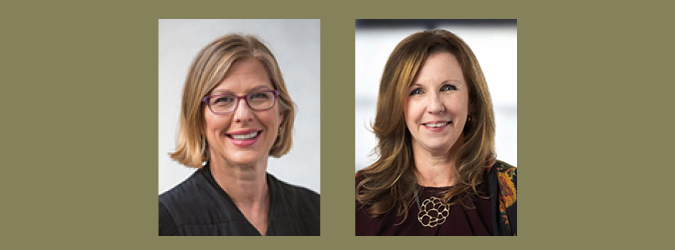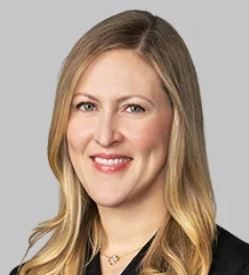The New York State Supreme Court Commercial Division: 30 Years of Empowering Women
2.19.2025

Justices Andrea Masley and Elizabeth Emerson (L-R above), who have played a critical role in the success of the Commercial Division, reflect on their respective paths to the Commercial Division bench and the value that the court brings to New York State and the practitioners before it. Former Commercial and Federal Litigation Section Chair Anne Sekel offers an introduction to these distinguished individuals.
Introduction:
By Anne Sekel
There are certain moments in time when unrelated events conspire to draw one’s attention to circumstances that might otherwise go unnoticed, but which are truly noteworthy.
Recently, the retirements of Justice Barry Ostrager from the New York County Commercial Division and Justice Elizabeth Emerson from the Suffolk County Commercial Division highlighted just such a circumstance. To explain, Justice Ostrager’s departure from the court paved the way for Justice Andrea Masley to ascend to the role of senior judge in New York County, and Justice Emerson’s retirement from the bench concluded the many years in which she had been the senior-most Commercial Division judge in Suffolk County. That the Commercial Division has such an abundance of senior talent, and in two women no less, is a testament to the uniqueness of the Commercial Division as a judicial institution and is a fact that should not be overlooked. Specifically, while the Commercial Division has long been recognized as a preeminent venue for business disputes in New York, what sometimes may not be as readily apparent is the critical role that women have played in its success and, similarly, the phenomenal opportunities that the Commercial Division affords female judges and attorneys alike.
Therefore, the New York State Bar Association’s Commercial and Federal Litigation Section, as a key proponent of the Commercial Division and a committed advocate for female business litigators in New York, wanted to acknowledge both the court and the brilliant and trailblazing women – like Justice Masley and Justice Emerson – who already have and continue to contribute to its success. In recognition of these accomplishments, the section extended, and Justices Masley and Emerson graciously accepted an invitation to reflect on their respective paths to the Commercial Division bench and the value that the court brings to New York State and the practitioners before it. Their respective observations follow this introduction.

From its beginning, the Commercial Division was a forum that provided special opportunities for the advancement of female judges. By way of brief background, in 1993, then-Administrative Judge Stanley S. Ostrau piloted a program comprised of four designated parts tasked with handling complex commercial litigations. Somewhat improbably given the composition of the state judiciary at that time, half the judges selected to participate in the pilot were women – in particular, Justice Beatrice Shainswit and Justice Myriam Altman. When the pilot program concluded and practitioners in New York, including the section and a state-appointed task force led by the section’s first chair, Bob Haig, called for the establishment of a permanent commercial division, it was then Chief Judge Judith S. Kaye who created the Commercial Division on a statewide basis.[1]
Over the years, the Commercial Division has been home to many truly extraordinary female jurists – including those elevated to Appellate Division and administrative judge positions such as Justices Myriam Altman, Helen Freedman, Sylvia Hinds-Radix, Barbara Kapnick, Deborah Karalunas, Karla Moskowitz, Anne Pfau, Saliann Scarpulla, and Sandra Sgroi, as well as other luminaries such as Eileen Bransten, Carolyn Demarest, Elizabeth Emerson, Marcy Friedman, Shirley Kornreich, Emily Pines, and Beatrice Shainswit. Their contributions helped shape the Commercial Division into the sought-after venue it is today, and their presence on the bench undoubtedly paved the way for the female justices who followed them. Even more critically perhaps, their presence served as a shining example of the heights which can be achieved by women in the Commercial Division and certainly encouraged female attorneys to persevere on their career paths in business litigation. To this day, the Commercial Division bench is replete with female judges who serve as role models for other woman in commercial litigation. Indeed, the current female Commercial Division justices – Nancy Bannon, Margaret Chan, Deborah Chimes, Melissa Crane, Sharon Gianelli, Marguerite Grays, Linda Jamieson, Andrea Masley, Nicole McGregor-Mundy, Anar Patel, Jennifer Schecter, and Gretchen Walsh – surely will continue to positively impact the court and business litigation practitioners for many years to come.
For its part, the Commercial and Federal Litigation Section remains dedicated to supporting the Commercial Division and working to enhance the role of women on the bench and before the court. In fact, the section’s two groundbreaking reports about women attorneys in New York State courtrooms – the 2017 report entitled, “If Not Now, When? Achieving Equity in the Courtroom and in ADR,” and the 2020 follow-up report, “The Time Is Now: Achieving Equality for Women Attorneys in the Courtroom and in ADR” – specifically identified efforts by the judiciary, including the Commercial Division, as one of the keys to increasing diversity on bench and in the bar. The section’s Hon. Judith S. Kaye Commercial Litigation Academy Scholarship, which is bestowed on junior female litigators to cover the cost of attending the section’s Commercial Litigation Academy, is specifically designed to achieve this diversity goal by increasing the number of women prepared to serve as first chair in large commercial cases.
Given all this, it is hard not to feel optimistic about the future of the Commercial Division and women on the court. With resources as wise and committed as Justices Masley and Emerson, the Commercial Division is sure to continue to lead the way for women in business litigation in New York . . . and the Commercial and Federal Litigation Section will continue to be there to lend its support.
Anne Sekel (pictured above) is former chair of the Commercial and Federal Litigation Section. This introduction and the following reflections first appeared in NYLitigator, a publication of the Commercial and Federal Litigation Section. For more information, please visit NYSBA.ORG/COMFED.
Endnote:
[1] See Commercial Division – NY Supreme Court, History, NYCourts.gov, https://ww2.nycourts.gov/courts/comdiv/history.shtml.
My Journey to the Commercial Division, a World Class Business Court:
By Justice Elizabeth Emerson (Ret.)
One of the great joys of my professional career is the 21 years that I spent as a justice of the New York State Supreme Court Commercial Division. The work was challenging and required a great deal of creativity and effort, and sometimes extraordinary patience, but the rewards were always beyond measure. It gave me the opportunity to be part of one of the world’s best business courts and to work and to collaborate with outstanding practitioners and jurists. Having been there since the early days of the Commercial Division, I also had the privilege of working with those such as Chief Judge Judith Kaye and Bob Haig, whose efforts brought the concept to life and provided me with the opportunity to participate in establishing its rules and to shape its practices and watch it grow and thrive to the point where it is now.
For the first six years of my 28 years on the bench, Suffolk County did not have a commercial division. I had often advocated for the creation of such a court in Suffolk County. I believed that Suffolk County had a thriving business community and the right demographics to support a dedicated business court. I also knew from my years in private practice that to compete, Suffolk County needed to join its sister jurisdictions by establishing a sophisticated business-minded court that would use innovative techniques to resolve business disputes. When Justice A. Gail Prudenti became the administrative judge for Suffolk County, she clearly saw the need and the benefit, and she asked me to prepare a proposal for the creation of such a court. I will forever be grateful for that assignment. In October of 2002, the Suffolk County Commercial Division was created, and I became the first justice assigned to that division.
The Commercial Division is an extraordinary place to practice, and I believe that it is one of the crown jewels of the New York State court system. It is an excellent place for young attorneys to learn commercial practice at the highest levels. The justices, the Commercial Division Advisory Council and the various bar associations, most notably the Commercial and Federal Litigation Section of the New York State Bar Association, are constantly working to provide opportunities and make it a welcoming and accessible place for all to practice. Certain recent examples include the project “If Not Now When” and the “Taking the Lead” program, both of which I have taken part in, and the many internship opportunities offered by all the judges within the division.
A brief summary of my legal career and my path to the bench might help to explain my enthusiasm for the Commercial Division. It is safe to say that my career path took a number of unexpected twists and turns and that I was presented with a number of unexpected opportunities that led me to the work that I really loved. That is why I encourage all lawyers, especially new lawyers, to keep an open mind when considering the type of practice that you intend to pursue.
I decided that I would become a lawyer around the age of 12. Looking back, I am not sure why. I did not know any lawyers, and I knew very little about what they did. I knew so little that I believed that you needed to go to law school in New York if you wanted to practice in New York City (which I did). It was that belief which, after graduating from Boston College, led me to Syracuse University College of Law. I was indeed fortunate, as I received an excellent legal education and interacted with professors who took a personal and genuine interest in my career. At their urging I worked in London with a firm of solicitors and obtained a summer position at the U.S. attorney’s office for the District of Columbia. I also competed as a member of the National Appellate Team and became a teaching assistant for legal writing and research. All of these opportunities were immensely valuable and set me firmly on the path to becoming a litigator.
Upon graduation I accepted an offer to become a first-year associate at White & Case. White & Case was then, and is now, an excellent law firm with practices across many disciplines. At the time, first-year associates were required to rotate through three of the main departments. I was so sure that I wanted to be a litigator that I took the unusual step of requesting to be excused from this rotation and to be assigned directly to the litigation department. My request was granted, and from that moment I focused exclusively on litigation matters. Due to the high level of the practice, I worked with and learned from some of the best commercial litigators. I did not always realize it, but my assignments gave me the chance to be part of and to work on some truly cutting-edge matters. As the firm’s litigation practice started to slow and corporate work began to grow, the corporate group asked that I be reassigned to that department. When advised of this transfer and having no insight into corporate work, I was blissfully unaware of the challenge this would present. Imagine my surprise to find myself as a soon-to-be third-year associate assigned to matters that seemed to have originated in a totally different world, that spoke a different language, operated by different rules, required different tasks and abided by different customs. Even client relationships and interactions proved to be different. Again, I was fortunate to work with and to learn from some of the best in the business, and I soon found that I relished the work.
Eventually my love of the corporate transactional practice caused me to make a significant mid-career switch, when I moved from White & Case to Shearman & Sterling. At that time this was an unusual thing to do, as lawyers did not move between firms as they do now. Although White & Case felt like home, and I truly enjoyed the work there, I wanted to broaden my experience and focus on a particular type of international finance. At the time, the international financial sector was gearing up for the next round of country debt restructuring, principally in Central and South America. Shearman & Sterling had previously represented the Bank Steering Committee established to work with several countries in this region and was set to do so again.
Generally, the term “bank steering committee” referred to a group of the leading global banks and also included the World Bank and the International Monetary Fund, which would conduct negotiations with the sovereign nations and help shape the structure of the instruments that would be offered to participating institutions as part of the restructuring process. While this would be a comprehensive restructuring of the dollar-denominated debt of these developing nations, matters related to important private sector restructurings in these countries were also a part of the overall series of transactions that the parties expected to complete.
Finally, this process helped to create a number of innovative environmental projects known at the time as “debt for nature” swaps. With this in mind I took the opportunity to move to Shearman & Sterling, and I had the opportunity to work on and to be responsible for parts of many of these extraordinary matters. As country debt and related matters came to a close, I expanded my practice by working on many different deals representing a variety of domestic and international clients, including banks, investment banks, and Fortune 500 companies across different sectors such as entertainment, communications, manufacturing and other similar industries. In 1992, I was elected to the partnership of Shearman & Sterling, making me one of the few woman partners of the firm.
My time both as an associate and a partner at Shearman & Sterling was exciting and extremely professionally rewarding. Again, I had the chance to work with some of the best lawyers in the world. The work, particularly the country debt and the merger and acquisition work, was extremely demanding. It required long hours and lots of travel, often on short notice. The concept of remote work or work/life balance did not exist. Email was not really in use, and documents had to be physically produced and distributed around the world. Part-time work was not widely available, and it did not exist for partners of the firm whose responsibilities were great. There were still relatively few women, particularly on the corporate side, either as practitioners or as clients. It was still common to be the only senior woman on a deal and sometimes the only woman in the room. More than once I was asked to make coffee or a photocopy when I was in fact the partner in charge.
It was when I decided to start a family that the difficulty of maintaining a transactional practice and a family life became apparent. It was at this time in my life that my name was put forward for a seat on the New York State Supreme Court. I was indeed fortunate to have been offered this opportunity, and I gratefully accepted the nomination to appear on the ballot. This was a contested election, so I was required to embark on a campaign throughout the 10th Judicial District (a district that stretched from Montauk to the border of Queens). I was one of the six candidates elected, and on January 1, 1996, I began my first term as a state Supreme Court justice. I was 38 at the time, making me one of the youngest justices and one of the few women on the bench in Suffolk County. Having the opportunity to become a Supreme Court justice allowed me to continue to practice in an area that I loved but to do so with a degree of control that was at the time not available in the deal world. Again, I will always be grateful for this opportunity.
Although I have enjoyed all aspects of my judicial career, I have truly enjoyed my time in the Commercial Division. As I have written before, this assignment allowed me to use many of the skills I learned in the corporate world, such as problem-solving and creative thinking to resolve issues that arise in litigation. Often when conferencing a case with counsel, I advocated for an approach to problem-solving that combined the method of negotiation used in the corporate world that expanded possibilities and allowed for creativity with the features of conventional litigation that provided structure and necessary answers to important or threshold questions. Combining these processes often created opportunities that were not possible when simply relying on one or the other. It is this feature of the Commercial Division that sets it apart.
I have seen how important it is for New York to maintain its status as one of the great financial capitals of the world. To do so, it must have a business court that supports and sustains the financial community. When I taught in an MBA program, I often began my lecture on the judicial system with a quote attributed to Jack Welch, the well-known former CEO of General Electric, where he stated that you cannot have a strong economy without a strong and independent court system. I agree wholeheartedly with this premise, and I would assert that the Commercial Division more than fills this role. I would encourage young practitioners, particularly women, to explore the many rewarding opportunities to practice in the Commercial Division.
This article appears in a recent issue of NYLitigator, a publication of the Commercial and Federal Litigation Section of NYSBA. For more information, please visit NYSBA.ORG/COMFED.
My Journey to the Commercial Division: A Judge’s Reflections
By Justice Andrea Masley
It has been my great fortune to have been blessed with a network of inspirational figures who have guided me and broadened my horizons as a person and as a judge.
I must begin with my mother. An ER nurse in Paterson, New Jersey, my mother treated women injured and dying due to botched abortion procedures. When the Supreme Court ruled in 1973 that abortion was constitutional, she protested against any who would try to abolish women’s essential new right. She brought me to demonstrations and made sure that my sisters and I – and anyone else who would listen – understood why the “right to choose” was vital to the health and safety of all women. It was my mother who introduced me to the impact a judge (or seven judges in this case) could make in people’s lives, but the thought of a life in law would not come to me until much later.
As a result of majoring in economics at Douglass College, Rutgers University, I was selected for an internship at the Chicago Federal Reserve. There I worked with a Rutgers alumna and vice president of the Chicago Fed on a report on daylight overdrafts by banks. Upon graduation, naturally, I went to Wall Street, where I worked for a soybean trader and learned how the world is fed. I was also introduced to arbitration, which was standard business practice in grain trading. However, there I was also disabused of the idea that women could be anything they wanted to be. For the first time in my life, I observed equally qualified men and women treated unequally. Since, unlike men, women were required to have credentials before they would be traders, which I thought I might like to be, I returned to Rutgers for an MBA.
During business school, I interned at the New York City Better Business Bureau, which led to a job as the business practices specialist, where I investigated banks, brokerage firms, modeling agencies, rental car agencies, coin dealers and even matchmaking firms (this was long before apps). There I met BBB President Barbara Opotowsky and General Counsel Rhonda Singer. They supported my dream of becoming a consumer advocate, but first, they said, I had to go to law school. They contributed to me being the lawyer I became. They encouraged me to join the City Bar Association. Rhonda taught me how to use McKinneys CPLR, including pocket parts,[1] reading all the commentary, finding relevant case summaries and reading the prior and subsequent statutes to find related context, which is why I sometimes still use the books. Barbara and I would work together again when she became the executive director of the New York City Bar Association, where she continued to guide me and my legal career. Rhonda and Barbara continue to support and mentor me to this day.
Because of these two impactful internships, I host interns from high school, college and law schools every semester, as well as during winter, spring and summer breaks, with the hope of providing the same opportunities that I had. Former interns have become a rich source of law clerks for me and my colleagues, and I learn so much from them.
Upon graduation from Fordham Law in 1991, I joined Dechert’s litigation department, where the importance of having Fordham in my life was immediately made clear to me. A Fordham alumnus, James Tolan, put me on his litigation team. Jim was my ally, making opportunities on cases for me. I worked with Jim on his major cases and on the minor cases that he took so junior associates could get experience. Among the many things I learned from him was how to take a deposition. Jim had been Judge Kaye’s law partner at Olwine Connelly Chase O’Donnell & Weyher, so I also learned a lot about Judge Kaye, who created the Commercial Division on a statewide basis, as a commercial litigator. Jim continued to support me after I left the firm, and even chaired my fundraising committees when I ran for election to Civil Court in 2006 and 2007.
Though I had been a member of the City Bar Association since 1991, I became counsel to executive director Fern Schair in 1995. Fern demonstrated how those who worked behind the scenes could change the legal profession and create opportunities for women and minorities. One of Fern’s most impactful rules was that a city bar program could not proceed unless its panel of speakers was diverse. When Fern worked with Hon. Betty Ellerin in Betty’s capacity as chair of the New York State Judicial Committee on Women in the Courts, I watched two brilliant strategists make the courts better for all of us: for example, improving translation services and establishing a network of gender fairness committees throughout all courts.
With Barbara Robinson as the first female president of the 125-year-old City Bar Association, my position evolved to diversity counsel. I worked with all the diversity committees on the various ways they make change. I was particularly influenced by Hon. Roz Richter, who co-chaired the LGBT Committee, which was drafting LGBT HR policies for law firms and legal departments. Roz and I would work together again on the Women in the Courts Committee when she, as chair, invited me to be the vice chair. We urged the Office of Court Administration to count the number of women, minority and LGBTQ+ lawyers who registered to practice law in New York to help organizations like the association provide meaningful programs and services. Later, Roz and her late wife Janet Weinberg encouraged me to become a judge and educated me on judicial politics. Roz continues to be a trusted advisor to me.
At this time, I also met Justice Charles Edward Ramos, then a member of the association’s board of directors. He brought me into the court’s law department. My job included drafting decisions for Justices Ramos, Ira Gammerman and Louise Gruner Gans, among others. I then became a law clerk for Judge Gans, whose meticulous reading of motion papers and case files set an example I follow to this day. I also had the good fortune to work with Marilyn Dershowitz, then a law clerk and later a special referee, who shared her years of wisdom and decision-writing secrets with me.
It was two of Justice Gans’ decisions in public housing cases that triggered my decision to become a judge. Simply put, I wanted the opportunity to make the kinds of decisions that impacted public policy and peoples’ lives.
As Judge Gans was approaching retirement, I became a law clerk for Judge Ramos in the Commercial Division. Together we worked on an eclectic array of cases, which is how I was introduced to many of the members of the New York State Bar Association’s Commercial and Federal Litigation Section who practice in the Commercial Division. Indeed, initially, former Section Chair Tracee Davis and I were co-clerks (and now, lifelong friends). The issues we addressed in decisions were wide-ranging and, in one case, harkened back to my BBB days, commenting on legislation that would protect models from abuse by modeling agencies. Judge Ramos and I did disagree about one thing that I can now disclose: rendering decisions from the bench on the record. I was wrong, and he was right; they are absolutely necessary. I dare say it was Judge Ramos who made me the judge I am today by example and with this simple advice that I think about daily: just follow the law and do what you think is right. He is also responsible for introducing me to Victoria Corbo, now my principal law clerk, whose first job out of law school was as a participant in Office of Court Administration’s fellowship program, which eventually became our current Commercial Division law clerk program.
At this time, I was appointed chair of the city bar’s State Courts of Superior Jurisdiction Committee. The committee issued the initial confidentiality agreement now used in the Commercial Division statewide. We also issued reports on en banc review[2] and e-discovery.[3] Triggered by my frustration with how little attorneys understood about where judges come from, the committee drafted a report to help lawyers and the public better understand and get involved in the judicial selection process.[4]
Next, I joined the Council on Judicial Administration. In response to the careless publication of a litigant’s children’s addresses and health records in a notorious case before Justice Ramos, the council drafted a redaction rule and report that eventually became Uniform Rules for Trial Courts Section 202.5(e). I also chaired a council subcommittee that issued a report explaining why the 1846 constitutional cap on the number of Supreme Court justices must be lifted to finally address the shortage of judges caused by the cap to all courts, not just the Supreme Court. But lifting the cap is not sufficient; we recommend a weighted case load average to calculate the number of judges needed in every court in the state, as is done in 34 other states and the federal courts. Our report, “Repeal the Cap and Do the Math: Why We Need a Modern, Flexible, Evidence-Based Method of Assessing New York’s Judicial Needs,” was published in September 2023 and quickly endorsed by both NYSBA’s Commercial and Federal Litigation Section and NYCLA, among others, for which I am eternally grateful.
I also volunteered on political campaigns since college and worked day and night on Karen Burstein’s 1994 campaign for New York State attorney general. A friend from the city bar’s Consumer Affairs Committee introduced me to my neighborhood political club, where I helped to collect signatures for political and judicial candidates and volunteered on presidential campaigns in other states. These experiences were invaluable when I decided to run for election as judge.
In 2007, I was elected to the Civil Court of the City of New York, 9th Judicial District, and in 2016 to the Supreme Court, New York County. In addition to assignments in Family and Civil Courts and a guardianship part, I sat in criminal arraignments on weekends and holidays, all of which very much informed my passion for contributing to the “Repeal the Cap and Do the Math” report because I witnessed the impact of the shortage of judges on the recently arrested held longer than necessary, families waiting for custody and visitation orders and incapacitated people in need of immediate help.
When I graduated from Fordham, I never expected to land in the Commercial Division. But given my business background, perhaps it was fated. I was assigned to the Commercial Division in June 2017, when Hon. Jeffrey Oing was appointed to the Appellate Division, First Department. I was impressed by his case management, well-organized oral decisions on the record and thoughtful decisions, and I strive to emulate his approach. My appointment was such a momentous event in my life that I still have Hon. George Silver’s voicemail from that day.
While it is an absolute joy to work with the greatest lawyers on the most complex and interesting cases in the world, it is also a huge responsibility to efficiently manage more than 350 cases and ensure that the Commercial Division’s stellar national and international reputation continues to attract these lawyers and cases to New York. I do so on the shoulders of all of those mentioned above and many others, and the assistance of three brilliant law clerks, the invaluable resource of my colleagues and very understanding friends and family, and especially my supportive husband, Dr. Samuel D. Albert.
This article appears in a recent issue of NYLitigator, a publication of the Commercial and Federal Litigation Section of NYSBA. For more information, please visit NYSBA.ORG/COMFED.
Endnotes
[1] Ask a partner about pocket parts.
[2] Committee on the State Courts of Superior Jurisdiction, En Banc Review in New York Courts, https://www.nycbar.org/wp-content/uploads/2023/05/En_Banc_Article.pdf.
[3] Joint Committee on Electronic Discovery, Association of the Bar of the City of New York, Explosion of Electronic Discovery in All Areas of Litigation Necessitates Changes in CPLR, August 2009, https://www.nycbar.org/wp-content/uploads/2023/05/20071732-ExplosionofElectronicDiscovery.pdf.
[4] Judicial Selection Methods in the State of New York: A Guide to Understanding and Getting Involved in the Selection Process, March 2014, https://www.nycbar.org/wp-content/uploads/2023/05/20072672-GuidetoJudicialSelectionMethodsinNewYork.pdf.






